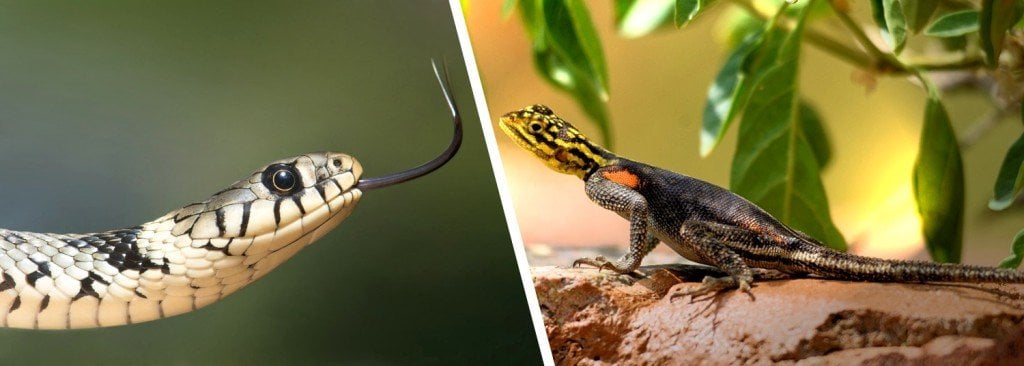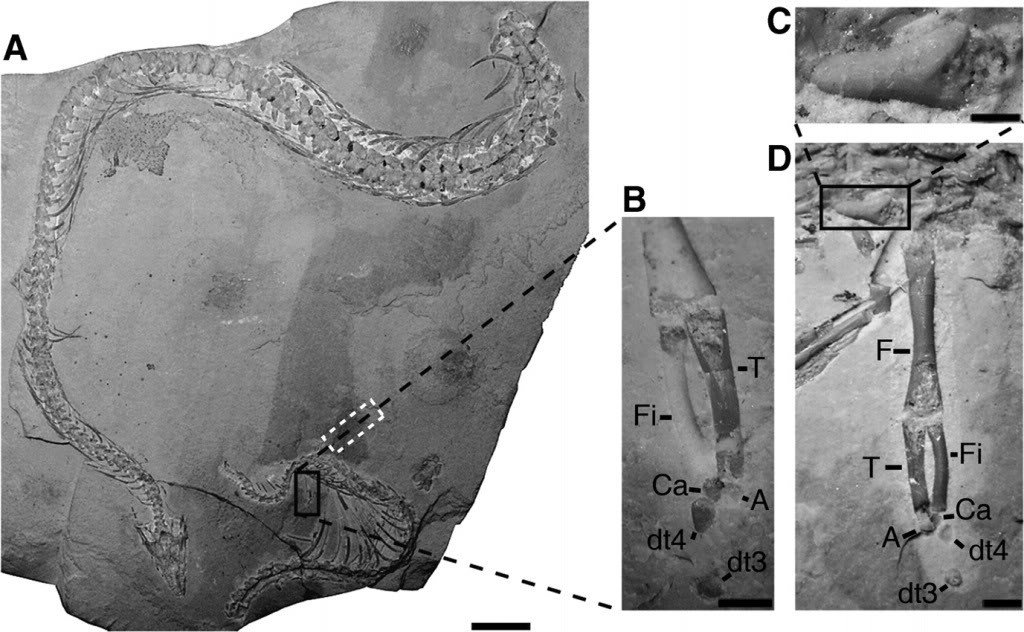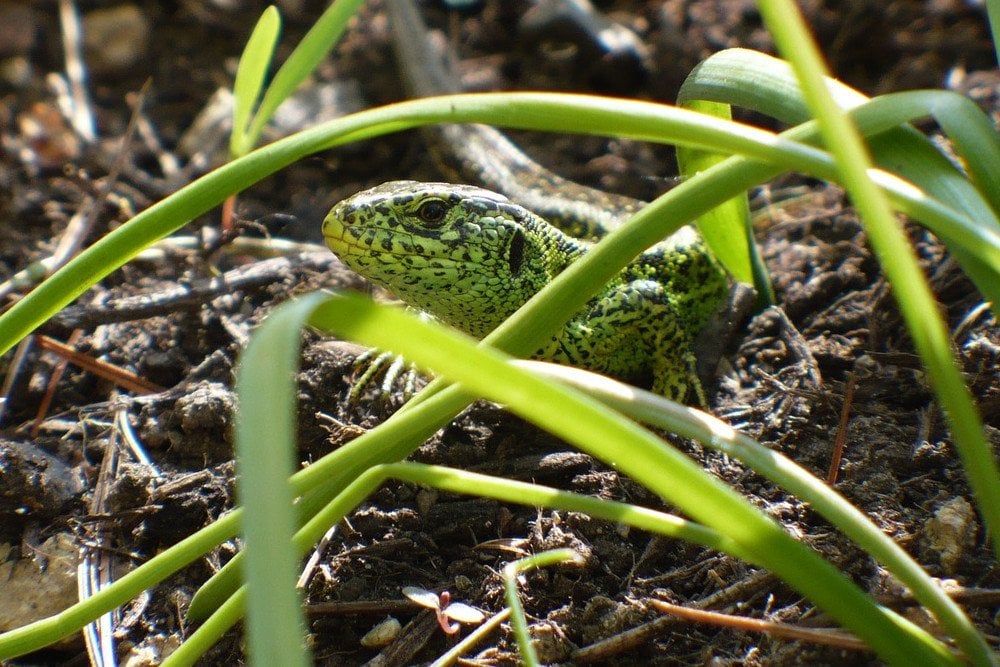Table of Contents (click to expand)
Snakes are legless reptiles that evolved from legged lizards. They lost their limbs because the presence of limbs impeded aquatic locomotion. Snakes also lost their limbs because the limbs grew at an extremely sluggish rate or grew them only for a very short period of time.
Snakes are elongated, carnivorous reptiles of the suborder Serpentes. Their most distinctive feature is their lack of appendages. Snakes are legless, so they move by slithering ahead, dragging and pulling their bodies across the ground.
Now, if a tail is an essential characteristic of the body of an animal, we must ask where does the snake’s body end and its tail begin? This is comical, yet a very profound philosophical problem, if you ask me. But let’s not dwell any further on it.
Instead, on a far more serious note, what we should focus on is the question of why snakes lost their legs in the first place?

The question essentially asks, why would nature deem this regression better for survival than having limbs like other reptiles? The dexterity would make burrowing far easier than it would be without a pair of forelimbs.
One groundbreaking paper claims that prehistoric snakes did possess limbs, albeit very thin ones. They gradually lost them due to certain energy constraints. Later, we’ll learn how these constraints imposed this regression and arrested the growth of limbs at the phase of manufacturing itself – at the level of genes.
Recommended Video for you:
Snakes With Ankle Bones
Zoologists predict that at some point in the past, some snakes, if not all, used to have legs. Snakes are believed to be evolved from legged lizards. The claims find their ground in the similarities between these reptiles. Both lizards and snakes possess the same sensory organs to locate prey. Both the male forms of these species possess the same reproductive organs. Both of these species are covered with scales and are cold-blooded animals.
However, due to a lack of concrete evidence, evolutionary zoologists have long been uncertain about this claim, but a new finding corroborates this theory.

The research suggests that snakes evolved from lizards that either excavated on land or swam in the ocean. However, the legs grew obsolete in either case as the animal evolved over time. It seems that they lost their limbs because the presence of limbs impeded aquatic locomotion. But what about excavating? Wouldn’t forelimbs aid with shoveling?
Well, zoologists claim that snakes seldom dug their own holes. Rather, they encroached and snuck into holes dug by smaller animals, probably potential prey. In this scenario, forelimbs would have surely made them larger than the hole and prevented them from accessing their food.
The presence of limbs would have been responsible for a formidable waste of energy. These constraints forced the regression to have no legs. The regression also occurred without any impact on the organism’s survival. The study highlights that the loss of limbs can be credited to the snakes growing them at an extremely sluggish rate or growing them only for a very short period of time.

For the study, Houssaye and her colleagues from the National Museum of Natural History in Paris rigorously examined a prehistoric fossil snake termed Eupodophis descouensi. The oldest snakes are believed to be dated as far back as 94-112 million years. This snake wasn’t amongst the very oldest, but it did come close, estimated to be roughly 90 million years old.
The scientists used a novel, highly advanced imaging technique called Synchrotron Radiation Computed Laminography (SRCL). The procedure uses large machines that allow us to magnify and view microscopic features in exquisite detail. More importantly, it causes no damages to these priceless specimens.
The machines expose a specimen to intense X-ray radiation that deeply penetrates the fossil through every crevice as it rotates on a substrate. The procedure generates thousands of high definition 2D images, which are compiled to form a sophisticated 3D model of the fossil.

The three-dimensional model of the fossilized snake illustrated the ancient snake’s hips and slender 2 cm legs! It showed 2 small, regressed hind limbs and an absence of front limbs. The palpable leg was bent at the knee and possessed 4 ankle bones, but it had no foot or toe bones. This morphology quite closely resembles the limbs of a modern-day terrestrial lizard.
Another snake of a similar age, Najesh rionegrina, is also predicted to have 2 infinitesimally thin rear legs. The snake displayed a sacrum, a triangular bony feature that supports the pelvis.
These features might have subtly departed as the animal evolved.
The Single Genetic Tweak That Caused The Snake To Lose Its Limbs
Even though, as I argued, the limbs of a snake would have impeded terrestrial activities, the genome of a snake tells a different story. It emulates the genome of a terrestrial lizard.
A highly elegant study revealed that the snake genome does possess genes for limb genesis and growth, but tiny mutations in DNA located near a gene pivotal to limb architecture and growth prevented the gene from ever activating in the first place, consequently changing their appearance forever.

This illustrates a scintillating butterfly effect where a tiny variation transmutes to consequential differences. The study highlights the spectacular vicissitudes that a single genetic mutation can induce. Zoologists claim this regression might have sprung into action some 150 million years ago.
The first clues about these genetic changes were sought by Martin Cohn, an evolutionary development biologist at the University of Florida, in 1999. He discovered that certain genes in a snake embryo participated in a different pattern of activity than other reptiles in the same state. He realized that introducing a growth factor could enable these embryos to start to grow limbs. However, because the gene-editing technology was only in its rudimentary stages, Cohn lacked the suitable tools to peek deeper.
Four years later, Hanken and his colleagues discovered that activity in a gene named Sonic hedgehog (Shh) played a significant role in limb formation and size in lizards, suggesting that it could also be significant for snakes.
As gene-editing technology caught up, scientists tracked the embryonic activity of pythons to examine why their legs grow, but never end up fully developed. The findings found 3 deletions in the genetic switch that controls the activity of the same Sonic hedgehog (SHH) gene!

The switch is formally termed the enhancer. The enhancer enacts a berth where all the proteins controlling this gene’s activity are delivered. The deletions make it difficult for the proteins to dock, thereby providing them with a narrow window of gene activity during the python’s embryo development that is crucial for any limb growth.
Alex Visel, a genomicist at the Lawrence Berkeley National Laboratory in Berkeley, California, compared genetic sequences of ancient snakes, such as pythons and boas, to newly evolved snakes like cobras and pythons. He found that the latter possessed no leg remnants that were present in the former. Their enhancers were replete with deletions and regressive mutations.
Researchers then attempted to test this enhancer’s influence on mouse limbs, to foresee its effects on the growth of their limbs. In an insightful experiment, researchers utilized the CRISPR-Cas9 gene-editing technique to replace a rodent’s own enhancer with the enhancers of other animals and then the enhancer of a snake.

When maturing with the enhancer of other species, the mouse legs grew conventionally. However, when replaced with the enhancer of a snake, the limb growth was restricted to small nubs! Moreover, when the researcher made the necessary additions to the DNA and placed the amended enhancer back into the mice, the leg growth resumed to its normal growth!
In this way, a microscopic tweak altering the rungs of snake DNA restricted any protruding appendage to an imperceptible bud, or in the case of new iterations of snake species, caused a regression to having no appendage at all.

However, scientists are still uncertain whether this tweak can be deemed the single, monumental mutation that introduced the trend of limblessness in lizards and facilitated their evolution into snakes. They believe this mutation might not be the sole perpetrator, but it is certainly a major actor in this unfolding drama.
For now, the common ancestor of all snakes still lurks in the shadows, elusive and reluctant to be identified.
References (click to expand)
- Research|Penn State: When did the snake lose its legs? - www.rps.psu.edu:80
- Tiny DNA tweaks made snakes legless | Science | AAAS. sciencemag.org
- Kvon, E. Z., Kamneva, O. K., Melo, U. S., Barozzi, I., Osterwalder, M., Mannion, B. J., … Visel, A. (2016, October). Progressive Loss of Function in a Limb Enhancer during Snake Evolution. Cell. Elsevier BV.
- How snakes lost their legs › News in Science ... - ABC. The Australian Broadcasting Corporation













